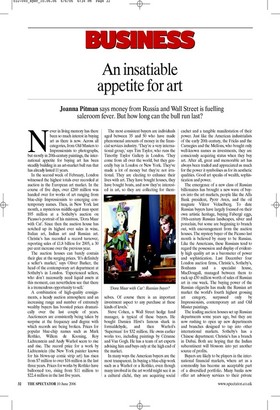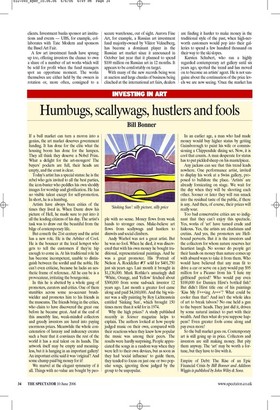BUSINESS
An insatiable appetite for art
Joanna Pitman says money from Russia and Wall Street is fuelling saleroom fever. But how long can the bull run last?
Never in living memory has there been so much interest in buying art as there is now. Across all categories, from Old Masters to Impressionists to photographs, but mostly in 20th-century paintings, the international appetite for buying art has been steadily building in an art-market bull run that has already lasted 11 years.
In the second week of February, London witnessed the highest totals ever recorded at auction in the European art market. In the course of five days, over £260 million was handed over for works of art ranging from blue-chip Impressionists to emerging contemporary names. Then, in New York last month, a mysterious middle-aged man spent $95 million at a Sotheby’s auction on Picasso’s portrait of his mistress, ‘Dora Maar with Cat’. Since then the auction house has notched up its highest ever sales in wine, Italian art, Indian art and Russian art. Christie’s has recorded a record turnover, reporting sales of £1.8 billion for 2005, a 30 per cent increase over the previous year.
The auction houses can barely contain their glee at the surging prices. ‘It’s definitely a seller’s market,’ says Oliver Barker, the head of the contemporary art department at Sotheby’s in London. ‘Experienced sellers, who don’t necessarily need liquid assets at this moment, can nevertheless see that there is a tremendous opportunity to sell.’ A combination of high-quality consignments, a heady auction atmosphere and an increasing range and number of extremely wealthy buyers has boosted prices dramatically over the last couple of years. Auctioneers are consistently being taken by surprise at the frequency and degree with which records are being broken. Prices for popular blue-chip names such as Mark Rothko, Willem de Kooning, Roy Lichtenstein and Andy Warhol seem to rise and rise. The record price for a work by Lichtenstein (the New York painter known for his blown-up comic strip art) has risen from $7 million to over $16 million in the last three years. Prices for works by Rothko have ballooned too, rising from $11 million to $22.4 million in the last five years. The most consistent buyers are individuals aged between 35 and 50 who have made phenomenal amounts of money in the financial services industry. ‘They’re a very international group,’ says Tim Taylor, who runs the Timothy Taylor Gallery in London. ‘They come from all over the world, but they generally buy in London or New York. They’ve made a lot of money but they’re not irrational. They are electing to enhance their lives with art. They have bought houses, they have bought boats, and now they’re interested in art, so they are collecting for them selves. Of course there is an important investment aspect to any purchase at these kinds of levels.’ Steve Cohen, a Wall Street hedge fund manager, is typical of these buyers. He bought Damien Hirst’s famous shark in formaldehyde, and then Warhol’s ‘Superman’ for $32 million. He owns earlier works too, including paintings by Cézanne and Van Gogh. He has a team of art experts advising him and buys only at the high end of the market.
In many ways the American buyers are the most transparent. In buying a blue-chip work such as a Warhol or a Rothko, even though many involved in the art world might see it as a cultural cliché, they are acquiring social cachet and a tangible manifestation of their power. Just like the American industrialists of the early 20th century, the Fricks and the Carnegies and the Mellons, who bought only well-known names as investments, they are consciously acquiring status when they buy art. After all, great and memorable art has always been traded and appreciated as much for the power it symbolises as for its aesthetic qualities. Good art speaks of wealth, sophistication and power.
The emergence of a new class of Russian billionaires has brought a new wave of buyers into the art markets, people like the Alfa Bank president, Pyotr Aven, and the oil magnate Viktor Vekselberg. To date Russian buyers have largely focused on their own artistic heritage, buying Fabergé eggs, 19th-century Russian landscapes, silver and porcelain, but some are beginning to branch out, with encouragement from the auction houses. The mystery buyer of the Picasso last month is believed by many to be Russian. Like the Americans, these Russians tend to regard the possession and display of evidently high quality art as a barometer of power and sophistication. Last December four London auction firms, Christie’s, Sotheby’s, Bonhams and a specialist house, MacDougall, managed between them to rack up £50 million worth of sales of Russian art in one week. The buying power of the Russian oligarchs has made the Russian art market the world’s fourth highest grossing art category, surpassed only by Impressionists, contemporary art and Old Master paintings.
The leading auction houses set up Russian departments some years ago, but they are now rushing to open up new departments and branches designed to tap into other international markets. Sotheby’s has a Chinese department. Christie’s has a branch in Dubai. Both are hoping that the Indian subcontinent will blossom into yet another source of profits.
Buyers are likely to be players in the international financial markets, where art as a commodity has become an acceptable part of a diversified portfolio. Many banks now offer art advisory services to their private clients. Investment banks sponsor art institutions and events — UBS, for example, collaborates with Tate Modern and sponsors the Basel Art Fair.
A few art investment funds have sprung up too, offering investors the chance to own a share of a number of art works which will be sold for profit when the fund managers spot an opportune moment. The works themselves are either held by the owners in rotation or, more often, consigned to a secure warehouse, out of sight. Aurora Fine Art, for example, a Russian art investment fund majority-owned by Viktor Vekselberg, has become a dominant player in the Russian art market since it announced in October last year that it planned to spend $100 million on Russian art in 12 months. It appears to be comfortably on target.
With many of the new records being won at auction and large chunks of business being clinched at the international art fairs, dealers are finding it harder to make money in the traditional style of the past, when high-networth customers would pop into their galleries to spend a few hundred thousand on their way to the ski slopes.
Karsten Schubert, who ran a highly regarded contemporary art gallery until six years ago, spotted the trend and has moved on to become an artists’ agent. He is not sanguine about the continuation of the price levels we are now seeing. ‘Once the market has



















































































 Previous page
Previous page